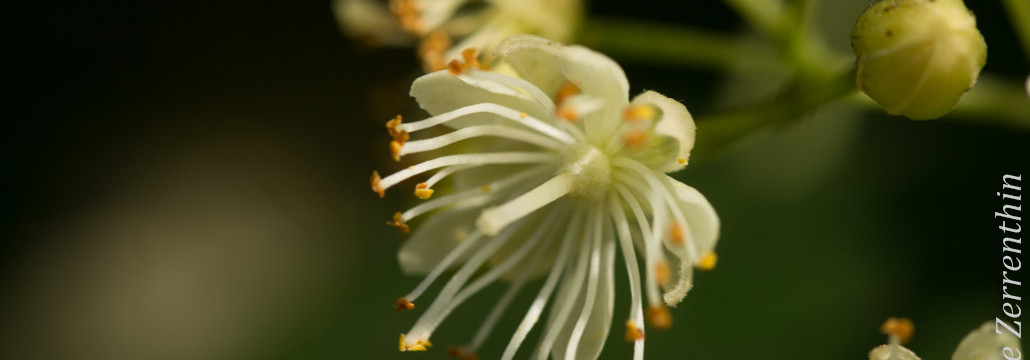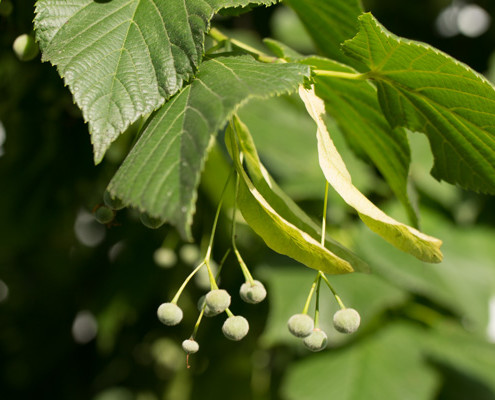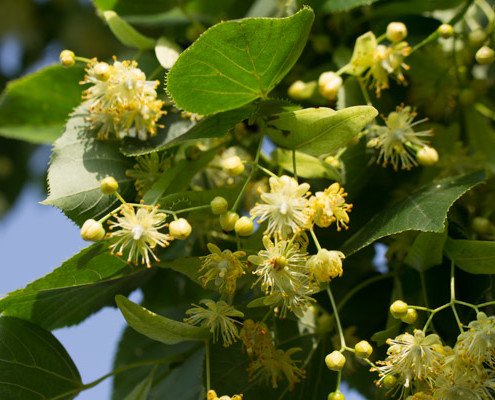Linden blossom – Be the Most Honoured Guest in your Heart
Growing up in Germany I have memories of the scent of the flowering linden trees in early Summer. The sweet heavy scent is intoxicating and is heightened on warm days and evenings enveloping your mind with an elated feeling of calm and joy. The streets in the old town centre of my childhood are lined with linden trees as are the streets, parks and city squares of Berlin where I lived in my early 20’s. The trees are so much part of the cultural landscape and have found places, streets, parks, squares named after it and well-known is the linden tree-lined avenue ‘Unter den Linden’ in the centre of Berlin leading to the Brandenburg Gate.
Native to the temperate regions of the Northern Hemisphere the linden (Tilia) is a genus of about 30 species of trees known also in Britain as lime and in North America as basswood. I liked reading about the origin of the names lime and linden in Wikipedia:
“Lime” is an altered form of Middle English lind, in the 16th century also line, from Old English feminine lind or linde, Proto-Germanic *lendā, cognate to Latin lentus “flexible” and Sanskrit latā “liana”.
“Linden” was originally the adjective, “made from lime-wood” (equivalent to “wooden”); from the late 16th century, “linden” was also used as a noun, probably influenced by translations of German romance, as an adoption of Linden, the plural of German Linde.
Latin tilia is cognate to Greek πτελέᾱ, ptelea, “elm tree”, τιλίαι, tiliai, “black poplar” (Hes.), ultimately from a Proto-Indo-European word *ptel-ei̯ā with a meaning of “broad” (feminine); perhaps “broad-leaved” or similar.”
Linden trees grow to a hight of 20 to 40 metres and can reach an age of 1000+ years. Throughout time the linden has played its part in human lives and consciousness and some of the Germanic mythology and folklore is highlighted in this article ‘Trees in Life and Myth’:
In mythology, the linden tree is a symbol of peace, truth and justice. This connection is from Germanic mythology where the linden tree is associated with Freyja, the motherly goddess of truth and love.
According to German folklore, it was not possible to lie while standing under a linden tree. Consequently, Germans often met under linden trees not only to dance and celebrate, but also to hold their judicial proceedings. Christianity later replaced Freyja with the Madonna and rededicated the trees to Mary, the mother of God.
In the past, herbalists and doctors used bark, leaves and flowers of the linden tree for their healing properties while today mainly the blossoms are used to make tea, tinctures and essential oils.
Used in a tea infusion, linden blossoms are beneficial for colds, coughs, restlessness and insomnia. Other treatments include rheumatic complaints, cramps, headaches and migraines.
Linden blossom essential oil supports the digestive system when experiencing cramps, indigestion or liver pain and the nervous system for headaches, insomnia, migraine, nervous tension and stress. With its calming effect on the nervous system it promotes sleep. The skin benefits from its soothing, softening and toning action and helps to deal with blemishes, freckles and burns.
Loving yourself…does not mean being self-absorbed or narcissistic, or disregarding others. Rather it means welcoming yourself as the most honored guest in your own heart, a guest worthy of respect, a lovable companion.
~ Margo Anand
The heart-shaped leaves of the tree link the energetic-emotional effects of the essential oil with the heart chakra, allowing a person to open their heart when feeling devoid of love. This relaxing oil balances emotions, calms anger, releases emotional blocks and is a good oil to be used for people who are grieving, suffering loss or rejection as it promotes self-love and self-esteem.
© 2013. Annette Zerrenthin
References: Lee Baxter. The Healing Botanicals. Creek Publications, 2005. Suzi Chiazzari. Colour Scents. Saffron Walden, 1998. Dr. Ute Kuenkele, Till R. Lohmeyer. Herbs for Healthy Living. Parragon, 2007 Julia Lawless. The Encyclopedia of Essential Oils. Thorsons, 1992. Wanda Sellar. The Directory of Essential Oils. Vermilion, 2001.



